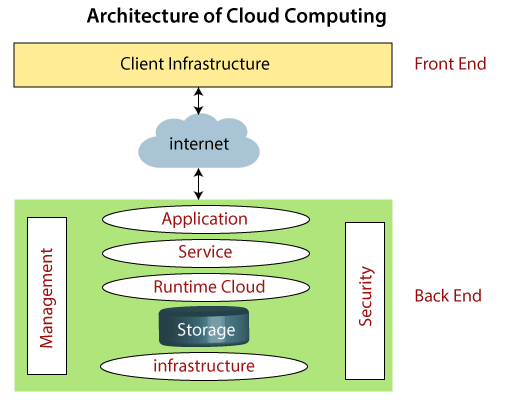Cloud Computing Architecture
As we know, cloud computing technology is used by both small and large organizations to store the information in cloud and access it from anywhere at anytime using the internet connection.
Cloud computing architecture is a combination of service-oriented architecture and event-driven architecture.
Cloud computing architecture is divided into the following two parts –
- Front End
- Back End
The below diagram shows the architecture of cloud computing –

Front End
The front end is used by the client. It contains client-side interfaces and applications that are required to access the cloud computing platforms. The front end includes web servers (including Chrome, Firefox, internet explorer, etc.), thin & fat clients, tablets, and mobile devices.
Back End
The back end is used by the service provider. It manages all the resources that are required to provide cloud computing services. It includes a huge amount of data storage, security mechanism, virtual machines, deploying models, servers, traffic control mechanisms, etc.
Note: Both front end and back end are connected to others through a network, generally using the internet connection.
Components of Cloud Computing Architecture
There are the following components of cloud computing architecture –
1. Client Infrastructure
Client Infrastructure is a Front end component. It provides GUI (Graphical User Interface) to interact with the cloud.
2. Application
The application may be any software or platform that a client wants to access.
3. Service
A Cloud Services manages that which type of service you access according to the client’s requirement.
Cloud computing offers the following three type of services:
i. Software as a Service (SaaS) – It is also known as cloud application services. Mostly, SaaS applications run directly through the web browser means we do not require to download and install these applications. Some important example of SaaS is given below –
Example: Google Apps, Salesforce Dropbox, Slack, Hubspot, Cisco WebEx.
ii. Platform as a Service (PaaS) – It is also known as cloud platform services. It is quite similar to SaaS, but the difference is that PaaS provides a platform for software creation, but using SaaS, we can access software over the internet without the need of any platform.
Example: Windows Azure, Force.com, Magento Commerce Cloud, OpenShift.
iii. Infrastructure as a Service (IaaS) – It is also known as cloud infrastructure services. It is responsible for managing applications data, middleware, and runtime environments.
Example: Amazon Web Services (AWS) EC2, Google Compute Engine (GCE), Cisco Metapod.
4. Runtime Cloud
Runtime Cloud provides the execution and runtime environment to the virtual machines.
5. Storage
Storage is one of the most important components of cloud computing. It provides a huge amount of storage capacity in the cloud to store and manage data.
6. Infrastructure
It provides services on the host level, application level, and network level. Cloud infrastructure includes hardware and software components such as servers, storage, network devices, virtualization software, and other storage resources that are needed to support the cloud computing model.
7. Management
Management is used to manage components such as application, service, runtime cloud, storage, infrastructure, and other security issues in the backend and establish coordination between them.
8. Security
Security is an in-built back end component of cloud computing. It implements a security mechanism in the back end.
9. Internet
The Internet is medium through which front end and back end can interact and communicate with each other.
